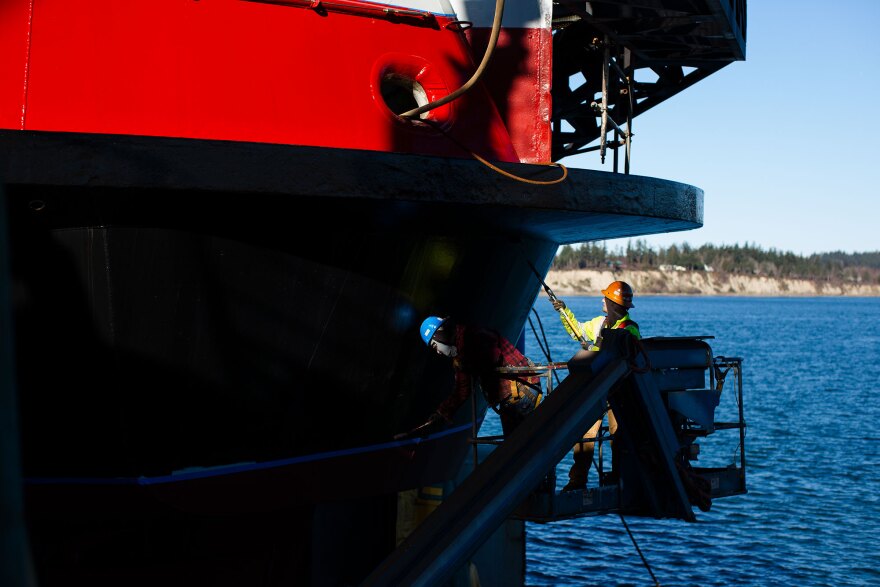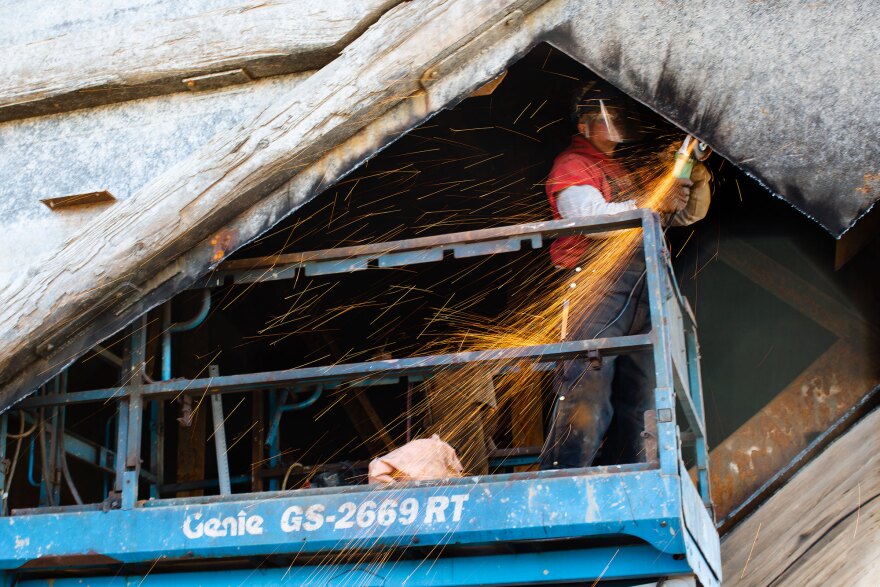MOUNT VERNON, WASH. — With more than a million visitors flocking to Skagit Valley every year for the Tulip Festival, it’s easy to think agriculture is the county’s biggest industry. But John Sternlicht, CEO of the Economic Development Alliance of Skagit County, says advanced manufacturing is king — at least in terms of money.
“I think there are even some people in Skagit County who might think first of agriculture and tulips when they think about us,” Sternlicht said.
BUILDING SHIPS
Skagit County is not a new home for manufacturers. Dakota Creek Industries has been here since 1977. The company has been in Mike Nelson’s family since it was founded in 1975. Skagit County — and this northern edge of Anacortes specifically — offers the geography and the workforce Nelson says his company needs.
They’ve made research vessels, tugboats and ferries.
On a recent January day, crews were giving the giant M/V Coho ferry a once-over in drydock. The 5,135-ton ship is sitting on giant blocks. Not far away, crews were finishing a factory trawler fishing vessel. And across the street from the shipyard, in the company’s fabrication building, workers welded and hammered two aluminum ferries. The vessels will eventually carry passengers around San Francisco Bay.
“The welding techniques are pretty advanced,” Nelson said. “And then the accuracy level has to be very good. Because everything changes as you weld it.”

AIRPLANE GUTS
Not far away, in Burlington, VT Volant makes and repairs commercial airline interiors. Those overhead bins, reading lights, flight attendant call buttons, seats, walls, windows, window shades and more all take a beating during the life of a passenger jet.
Airlines strip out the interiors of their planes, send them here, and the company sends some already restored parts to get the plane refurbished and back up in the air as soon as possible, then gets to work on the stuff that just arrived.
Tom Thompson, vice president and general manager, said his company has a $6 million backlog.
“Customers are demanding more than we can put out right now, which is a wonderful problem to have,” he said. “At the beginning of the year last year we were at about 75 people. Right now we’re at about 104. Our expectation is to be somewhere between 130 to 145 by the end of this year.”
On the factory floor, Larry Morris is sitting at a worktable, wiring a panel for overhead reading lights. The 79-year-old has worked here nearly a decade. He’s training Felicisima Kasinger, who just started. Kasinger is returning to the workforce after recovering from a surgery. This work, she says, is more interesting and less exhausting than her old job with FEMA, which required a lot of travel.
“It fascinates me because I always wanted to be an engineer,” Kasinger said. “I used to work for G.E. in the 70s.”
She worked with technicians on that job, but never pursued the field. This job lets her do that.

THE FUTURE
Business is good for VT Volant — and lots of other manufacturers — but there are worries, too.
“If people want to work here but they can’t afford to live here — and that’s what’s happening in King County — people have to move,” said Thompson, the general manager. “How do we make sure that we continue to grow an economy properly but also keep it affordable for people who want to live in the county?”
Skagit County is between two big metro areas, with about 6 million people. That’s good for a lot of businesses, which find themselves close to two big customer bases. But it also brings worries of a squeeze. What happens when the people who are moving away from expensive urban centers decide to start building here?
Sternlicht, the economic development official, says local governments have prioritized maintaining the region’s natural beauty and agricultural lands. And what’s happening in Skagit County, economically, isn’t quite the rapid change people are witnessing in Seattle and other areas.
“I might say a ‘boomlet’ rather than an entire boom,” Sternlicht said. “We have experienced in-migration but what we also have is a good chunk of our population that leaves Skagit County every day to work outside the county.”
I might say a 'boomlet' rather than an entire boom. We have experienced in-migration but what we also have is a good chunk of our population that leaves Skagit County every day to work outside the county.
He thinks the next decade will bring small to medium manufacturers into Skagit County. That’s not a drastic change, but he also acknowledges that nothing stays the same. Anacortes, for example, is home to refineries, which are an important part of the local economy.
“We all recognize on some level that reliance on fossil fuels will be decreasing over the next decades,” Sternlicht said, “and we need to make sure that the people who work here and live here have those good, family-wage jobs that will be existing in the future.”
There’s some balancing to do — retaining the business that exists now, recognizing some of it might change or diminish in the decades to come, and attracting new companies that want to make their home here. But Sternlicht and others here feel the Skagit Valley is poised to adapt to whatever the future has in store.








